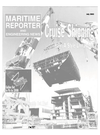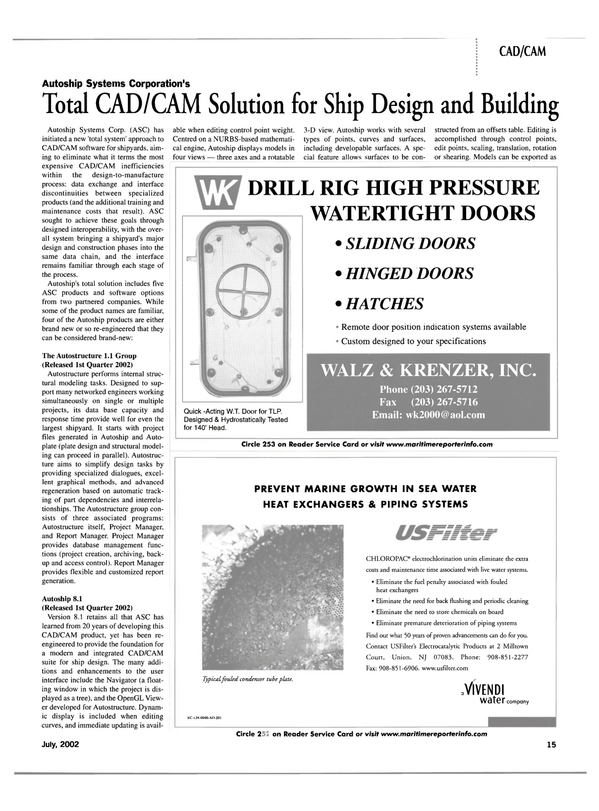
Total CAD/CAM Solution for Ship Design and Building
Autoship Systems Corp. (ASC) has initiated a new 'total system' approach to CAD/CAM software for shipyards, aiming to eliminate what it terms the most expensive CAD/CAM inefficiencies within the design-to-manufacture process: data exchange and interface discontinuities between specialized products (and the additional training and maintenance costs that result). ASC sought to achieve these goals through designed interoperability, with the overall system bringing a shipyard's major design and construction phases into the same data chain, and the interface remains familiar through each stage of the process.
Autoship's total solution includes five ASC products and software options from two partnered companies. While some of the product names are familiar, four of the Autoship products are either brand new or so re-engineered that they can be considered brand-new: The Autostructure 1.1 Group (Released 1st Quarter 2002) Autostructure performs internal structural modeling tasks. Designed to support many networked engineers working simultaneously on single or multiple projects, its data base capacity and response time provide well for even the largest shipyard. It starts with project files generated in Autoship and Autoplate (plate design and structural modeling can proceed in parallel). Autostructure aims to simplify design tasks by providing specialized dialogues, excellent graphical methods, and advanced regeneration based on automatic tracking of part dependencies and interrelationships.
The Autostructure group consists of three associated programs: Autostructure itself, Project Manager, and Report Manager. Project Manager provides database management functions (project creation, archiving, backup and access control). Report Manager provides flexible and customized report generation.
Autoship 8.1 (Released 1st Quarter 2002) Version 8.1 retains all that ASC has learned from 20 years of developing this CAD/CAM product, yet has been reengineered to provide the foundation for a modern and integrated CAD/CAM suite for ship design. The many additions and enhancements to the user interface include the Navigator (a floating window in which the project is displayed as a tree), and the OpenGL Viewer developed for Autostructure. Dynamic display is included when editing curves, and immediate updating is avail- able when editing control point weight.
Centred on a NURBS-based mathematical engine, Autoship displays models in four views — three axes and a rotatable 3-D view. Autoship works with several types of points, curves and surfaces, including developable surfaces. A special feature allows surfaces to be constructed from an offsets table. Editing is accomplished through control points, edit points, scaling, translation, rotation or shearing. Models can be exported as DXF and IGES files, Autohydro geometry files, or Offshore Racing Council IMS offset files. During export calculations the program enforces specified tolerances to ensure true engineering accuracy.
Autoplate 8.1 (Released 1st Quarter 2002) This new Autoplate product has been developed and updated to be able to work in tandem with Autostructure 1.1, and to import project files from Autoship 8.1.
Autoplate now incorporates the OpenGL Viewer developed for Autostructure, and "Navigator" — a new feature used to access and control project structure (see description of Navigator in Autoship 8.1 section above). Another new feature is ability to create plates that extend across the center plane (by reflection).
Plate boundaries can be surface edges, chines and embedded curve sections. A full range of expansion options is available to match fabrication methods, and the output includes plate measurements, pin jigs, templates and strain contours. Dynamic display is incorporated to let the user see the results of the editing compared to the unedited form, and Autoplate also generates shell expansion drawings.
Autohydro 5.3 This hydrostatics/stability component was released in June 2002. Autohydro is a development of the longsuccessful product used by naval architects around the world, and is also at the core of ASC's on-board stability software. It performs intact and damaged analyses and produces customized stability reports which are accepted by all major governing approval bodies.
Improvements include summarized reporting of load- ing conditions, a trim list correction table for tank sounding/ullage, SI units (longitudinal strength calculations in KN), local strength checking, and grain stability checking.
Autopower 3.0 As the resistance and power prediction component, this program provides 12 resistance prediction methods suitable for displacement vessels, planing vessels, semi-displacement vessels and catamarans. Hull parameters may originate in Autoship, then Autopower's advanced user interface enables optimization based on the available methods. Autopower also provides propeller optimization, analysis of 5 models concurrently, editable reports, rapid calculation and output, and a built-in Report Editor.
ASC has concluded co-operation and marketing agreements with two major players in the ship design and construction field: • The Perception suite from Spar USA (http://www.sparusa.com) does cost estimation, material management, scheduling and work management.
Direct transfer of part information from Autostructure will provide a link into the shipyard supply chain.
• AutoPLANT from Rebis (http://www.rebis.com) is an advanced piping design system. Working together, Autostructure and AutoPLANT provide designers with the ability to incorporate structural-piping design into the structure design drawings — which is much less costly than resolving structure/pipe interference during the build process.
Circle 185 on Reader Service C a rd w w w . m a r i t i m e r e p o r t e r i n f o . c om
Read Total CAD/CAM Solution for Ship Design and Building in Pdf, Flash or Html5 edition of July 2002 Maritime Reporter
Other stories from July 2002 issue
Content
- Zodiac Debuts Bulletproof System For CRRC page: 5
- Historic $17 Billion Order Placed page: 6
- USCG Proposes New Changes in Vessel Arrival/Departure Procedures page: 9
- NASSCO Celebrates Keel Laying of Trailerships page: 11
- Industry-Wide Interoperability Investment Paying Off page: 12
- Tribon M2 Aim: Better Ships at a Lower Cost page: 14
- Total CAD/CAM Solution for Ship Design and Building page: 15
- Juniper Industries Keeps the Water Out page: 17
- Molding the five-deck Trailership page: 18
- IZAR Gijon Delivers Dredger page: 19
- Estonians Raise the Ferry Stakes page: 19
- Transportation Secretary Announces $92.3M in Port Security Grants page: 21
- USS Shoup Commissioned page: 23
- U.K. Royal Navy Increases Overhaul Efficiency of HP Air Cylinders page: 24
- DD(X) Dispute: BIW Files Protest page: 25
- Technological Wonder, No Matter How You SLICE It page: 26
- GALILEO: 2008 or Bust? page: 28
- Forget the Dog, MTN Delivers the News Onboard Residensea page: 29
- SeaWave Aims to Drive Down Communication Costs page: 29
- Iridium Aggressively Pursues New Outlets page: 30
- Fincantieri Stays Strong page: 32
- Fincantieri Predicts Clear Vista For HAL page: 32
- Rodriquez Cantieri Navali: Fast Company page: 33
- SEA RIDER Infiltrates Small Craft Propulsion Market page: 34
- ACG Makes Solid Inroads page: 35
- SubSea Solutions Alliance Provides Quick Fix - Underwater page: 36
- Classic Vessel's Demise Lead to New Found Hobby page: 38
- STAR Center Provides 360-Degree Field of View page: 41
- MAN B&W 48/60B Engine page: 42
- Titan Pulls One Off for Marine Response Alliance page: 54


